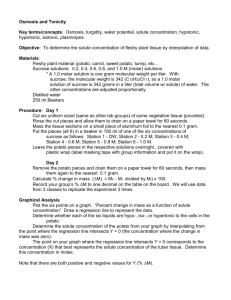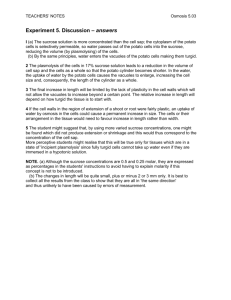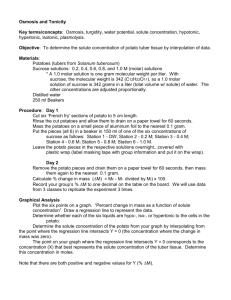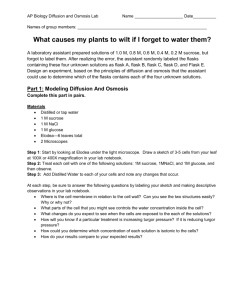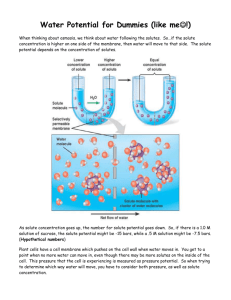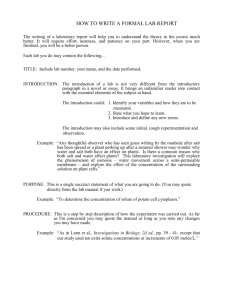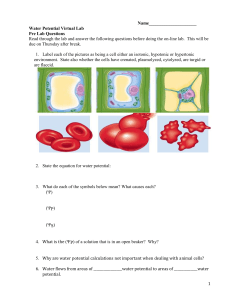Water potential lab worksheet
advertisement
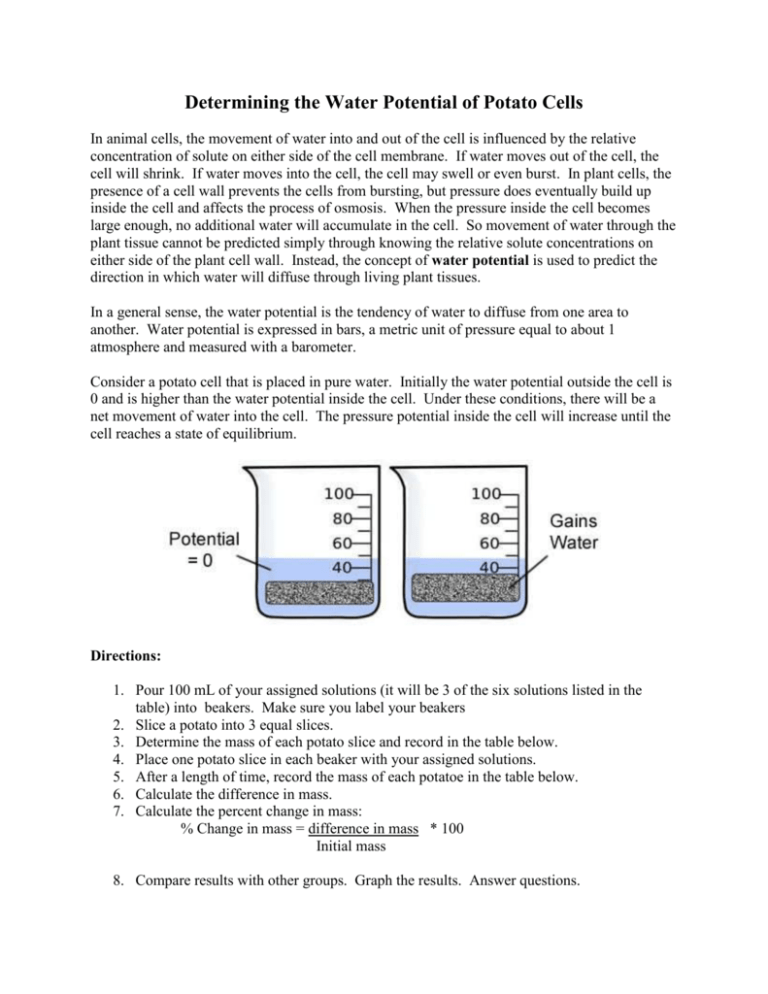
Determining the Water Potential of Potato Cells In animal cells, the movement of water into and out of the cell is influenced by the relative concentration of solute on either side of the cell membrane. If water moves out of the cell, the cell will shrink. If water moves into the cell, the cell may swell or even burst. In plant cells, the presence of a cell wall prevents the cells from bursting, but pressure does eventually build up inside the cell and affects the process of osmosis. When the pressure inside the cell becomes large enough, no additional water will accumulate in the cell. So movement of water through the plant tissue cannot be predicted simply through knowing the relative solute concentrations on either side of the plant cell wall. Instead, the concept of water potential is used to predict the direction in which water will diffuse through living plant tissues. In a general sense, the water potential is the tendency of water to diffuse from one area to another. Water potential is expressed in bars, a metric unit of pressure equal to about 1 atmosphere and measured with a barometer. Consider a potato cell that is placed in pure water. Initially the water potential outside the cell is 0 and is higher than the water potential inside the cell. Under these conditions, there will be a net movement of water into the cell. The pressure potential inside the cell will increase until the cell reaches a state of equilibrium. Directions: 1. Pour 100 mL of your assigned solutions (it will be 3 of the six solutions listed in the table) into beakers. Make sure you label your beakers 2. Slice a potato into 3 equal slices. 3. Determine the mass of each potato slice and record in the table below. 4. Place one potato slice in each beaker with your assigned solutions. 5. After a length of time, record the mass of each potatoe in the table below. 6. Calculate the difference in mass. 7. Calculate the percent change in mass: % Change in mass = difference in mass * 100 Initial mass 8. Compare results with other groups. Graph the results. Answer questions. Data Table: Initial Mass Final Mass Solution Distilled Water 0.2 M 0.4 M 0.6 M 0.8 M 1.0 M Mass Difference Solution hypo or %Change in hypertonic Mass compared to cell Questions: 1. What was the purpose of this lab? 2. Determine the molar concentration of the potato cores. This would be the sucrose molarity in which the mass of the potato core does not change. To find this, draw the straight line on your graph that best fits your data. The point at which this line crosses the x axis represents the molar concentration of sucrose with a water potential that is equal to the potato tissue water potential. At this concentration, there is no net gain or loss of water from the tissue. What is the Molar concentration of the potato? ___________ 3. Calculate the solute potential ( ΨS ) for the sucrose solution using the formula below. Show your work! ΨS= ___________ Solute Potential Formula ΨS= -iCRT i = ionization constant (for sucrose, this is 1 because sucrose does not ionize in water) C = molar sucrose concentration at equilibrium (determined from question #1 above) R = pressure constant (0.0831 liter bar/mole °K ) T = temperature °K (273 + °C ) 4. Explain how to determine the molarity of sucrose in a potato. (ie. Sum up the lab). 5. Explain water potential and describe how it affects osmosis. 6. What is turgor pressure? 7. In a hypotonic solution, would the turgor pressure be high or low? Would the plant cell be turgid, flaccid, or shrunken in (plasmolyzed)? 8. In a hypertonic solution, would the turgor pressure be high or low? Would the plant cell be turgid, flaccid, or shrunken in (plasmolyzed)? 9. In an isotonic solution, would the turgor pressure be high or low? Would the plant cell be turgid, flaccid, or shrunken in (plasmolyzed)? 10. Will water move into or out of a plant cell if the cell has a higher water potential than its surrounding environment? 11. Why is it important of an IV solution to have salts in it? 12. What would happen if you were given pure water in an IV?

